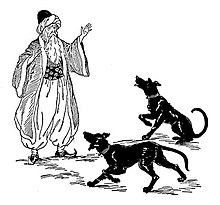
Harem pants or harem trousers are baggy, long pants caught in at the ankle. Early on, the style was also called a harem skirt. The original so-called 'harem pants/skirts' were introduced to Western fashion by designers such as Paul Poiret around 1910, although they themselves were inspired by Middle East styles, and by şalvar (Turkish trousers). The term 'harem pants' subsequently became popular in the West as a generic term for baggy trousers caught in at the ankle that suggest the Turkish style, or similar styles such as bloomers, the South Asian shalwar and patiala salwar; the Bosnian dimije; sirwal (as worn by Zouaves); and the Ukrainian sharovary.
Early 20th century
 19th century Algerian woman wearing the traditional pants which inspired 'harem pants'.
19th century Algerian woman wearing the traditional pants which inspired 'harem pants'. Paul Poiret harem pants, 1911
Paul Poiret harem pants, 1911
In 1911, the Paris couturier Paul Poiret introduced harem pants as part of his efforts to reinvent and 'liberate' Western female fashion. His "Style Sultane" included the jupe-culotte or harem pant, made with full legs tied in at the ankle. Alternative names for the harem skirt/pants included jupe-sultane (sultan skirt), and jupe-pantalon (trouser-skirt). These designs were seen as controversial as Western women typically did not wear trousers. Poiret's explicit exoticism and references to Middle Eastern styles, using the imagery of harems and sultans to establish his Orientalist style, was widely regarded as immoral and inappropriately sexualised. Poiret himself insisted that he designed harem pants for the chic woman to show off "the harmony of her form and all the freedom of her native suppleness." Adam Geczy suggests that harem pants, as a direct cultural appropriation, represent the point at which Western fashion began seriously challenging traditional cultural claims to their own styles. Despite the fierce criticism from other designers such as Jeanne Paquin who specifically criticised how harem pants slumped rather than tapered at the ankle (unlike the hobble skirt), it was noted that Paquin's own collections showed signs of having been influenced by the new styles. Although Poiret is often credited with single-handedly inventing trousers for Western women, the couturier Jeanne Margaine-Lacroix presented wide-legged trousers in 1910, and a fellow couturier, Bourniche, is also credited with designing such styles at the time.
Late 20th century

Harem pants came back into fashion in the 1980s, when they were remembered for being 'costumey.' A version of harem pants popularized in the late 1980s by M. C. Hammer became known as Hammer pants.
Contemporary harem pants
Harem pants are commonly worn with a pleated skirt—a short skirt that covers the top portion of the harem pants. Both harem pants and pleated skirts are commonly used in belly dancing. Harem pants are also used as a look alike for a dhoti in India.
See also
References
- Rossen, Jake (12 September 2021). "A Brief History of M.C. Hammer's Pants". Mental Floss. Retrieved 11 September 2024.
- ^ Cumming, Valerie; Cunnington, C.W.; Cunnington, P.E. (2010). The dictionary of fashion history. Oxford: Berg. p. 185. ISBN 978-1847887382.
- Fukai, Akiko (2002). Fashion : the collection of the Kyoto Costume Institute : a history from the 18th to the 20th century. Köln : Taschen. p. 724. ISBN 9783822812068.
- ^ Davis, Mary E. (2007). Classic chic : music, fashion, and modernism. Berkeley: University of California Press. pp. 31–34. ISBN 978-0520245426.
- ^ Geczy, Adam (2013). Fashion and orientalism : dress, textiles and culture from the 17th to the 21st century (1. publ. ed.). London : Bloomsbury. pp. 137–8. ISBN 9781847885999.
- Hefferman, Teresa; Bowman Dodd, Anna (1903). "Introduction (2005)". In the Palaces of the Sultan (2005 ed.). Gorgias Press LLC. p. xi. ISBN 9781593332044.
- ^ Geczy, Adam (2013). Fashion and orientalism : dress, textiles and culture from the 17th to the 21st century (1. publ. ed.). London : Bloomsbury. p. 147. ISBN 9781847885999.
- Milford-Cottam, Daniel (2014). Edwardian fashion. Shire Books. p. 55. ISBN 9780747814047.
- Mulvagh, Jane (1992). Vogue history of 20th century fashion. London: Bloomsbury Books. p. 19. ISBN 9781854710819.
- Art Bulletin of Victoria, Issues 34-36. Victoria: Council of the National Gallery of Victoria. 1994. p. 35.
Mulvagh, p. 19, suggests that the jupe culotte was introduced by Poiret, Bourniche and Margaine-Lacroix, while books on Poiret credit it to him alone.
- Gunn, Tim; Calhoun, Ada (2012). Tim Gunn's fashion bible : the fascinating history of everything in your closet (1st Gallery Books hardcover ed.). New York: Gallery Books. p. 94. ISBN 9781451643862.
- In The 80s — Clothes of the Eighties, Harem Pants
- "Stylish Harem Pants". Sew Guide. 22 April 2016. Retrieved 13 May 2016.
- "Aditi Rao Hydari practiced her Bharat Natyam skills home in a black top and printed harem pants". 20 May 2020.
External links
![]() Media related to Harem pants at Wikimedia Commons
Media related to Harem pants at Wikimedia Commons
